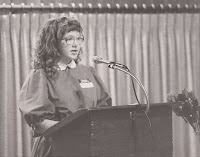Growing up in an evangelical home, I was taught that saving souls was the most important thing we could do. Because I was homeschooled, however, I wasn’t exposed to a lot of unsaved people as a child. There were the international students my parents sponsored, but these students were older than I was, and evangelizing them was more my parents’ game. I did try to evangelize several relatives, one aunt in particular, but (perhaps unsurprisingly) that didn’t go so well. One reason I decided to attend a secular college rather than a Christian one was my desire to evangelize—something I had found difficult to do in an already evangelical environment.
Evangelizing my peers in college didn’t go so well either, and looking back, I’m starting to realize why. Oh, there are lots of reasons evangelization will face challenges regardless of the particulars. Evangelicals tend to under-appreciate the staying power of more moderate or progressive Christian traditions, and they tend to undervalue these traditions more generally. Additionally, atheists and agnostics generally have a firm grip on why they believe or don’t belief what they do or don’t. There is usually a very narrow margin for evangelization—those who dissatisfied with their current belief structure and open to change.
But I had a more pressing problem. I stuck out, and not in a good way.
Let’s start with my physical appearance. I wore my hair in two braids every day, I didn’t pluck any facial hair (a mistake, with my genes), and I wore jumpers or T-shirts with frumpy skirts. In college. There were reasons for this, of course. I believed it was ungodly to spend too much time on my appearance, and that makeup or facial hair removal reflected an attempt to be physically attractive (something that fades and is fundamentally unimportant) rather than letting my inner beauty shine through. As for my clothes, well, I was trying not to draw attention to my curves, because curves could lead men to sin (i.e. lust).
I don’t have any pictures of myself to show, and it wasn’t a time in my life I really want to revisit. But what made me think about all this again was coming upon this picture on another blog:

The photo was captioned “MI Right to Life oratorical contest” and is from the blogger’s teenage years. But that dress. I remember those dresses. I wore those dresses too. I wore dresses like that in college.
And then I wondered why no one took me seriously.
When it comes down to it, if you want to evangelize someone, to persuade them to adopt a new belief system, you have to make them want what you have. And to do that, you have to make what you have attractive to them. I did know this, at the time. I suppose I thought what I had would shine through and that my appearances didn’t matter. The problem was not simply that appearances affect people’s perceptions whether we think they should or not—although the was at issue—but also that my appearances belied something else: my position as a cultural outsider.
I was a cultural outsider by design. I grew up outside mainstream American culture. My parents likened it to a greenhouse—they were raising me in an insulated evangelical homeschool environment to keep me safe until I was strong enough to weather the elements outside that environment. The result was that I had no idea how the world worked outside of my evangelical homeschool “greenhouse.” I didn’t understand cultural references, I didn’t even know how to talk to or interact with peers who weren’t homeschooled. It was like a foreign culture.
I didn’t know the culture, I didn’t understand the culture, I couldn’t speak the culture, and somehow I still thought I could evangelize the culture. It was a colossal, absolute blunder. Looking back it’s hard to believe I was that naive—but I was.
I would have done far better to learn to understand the culture and my peers. I would have done far better to dress in a way that did not automatically identify me as an outsider. I would have done far better to model a way to be an evangelical Christian without being a complete cultural outsider—a way people could adopt evangelical beliefs, if they were at a point in their lives where they were ready to try new ones, without walling themselves themselves off from the larger society.
But then, I didn’t know how to do those things myself.
Note: I am by not suggesting that we should judge people on their appearances or that women’s natural facial hair is a problem. I had a unibrow and was wearing culturally out of place clothing when I met the man who is now my husband; dressing and appearing this way does not make one unlovable. But if one’s goal is evangelizing, and not just living life and forming friendships, looking completely out of place and out of step with cultural norms is not going to smooth the way in a purely pragmatic sense.
I have a Patreon! Please support my writing!















